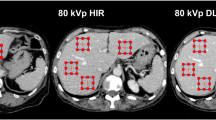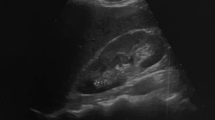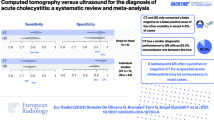Abstract
Purpose
Urolithiasis is a chronic condition that leads to repeated CT scans throughout the patient's life. The goal was to assess the diagnostic performance and image quality of submillisievert abdominopelvic computed tomography (CT) using deep learning-based image reconstruction (DLIR) in urolithiasis.
Methods
57 patients with suspected urolithiasis underwent both non-contrast low-dose (LD) and ULD abdominopelvic CT. Raw image data of ULD CT were reconstructed using hybrid iterative reconstruction (ASIR-V 70%) and high-strength-level DLIR (DLIR-H). The performance of ULD CT for the detection of urinary stones was assessed by two readers and compared with LD CT with ASIR-V 70% as a reference standard. Image quality was assessed subjectively and objectively.
Results
266 stones were detected in 38 patients. Mean effective dose was 0.59 mSv for ULD CT and 1.96 mSv for LD CT. For diagnostic performance, sensitivity and specificity were 89% and 94%, respectively, for ULDCT with DLIR-H. There was an almost perfect intra-observer concordance on ULD CT with DLIR-H versus LDCT with ASIR-V 70% (ICC = 0.90 and 0.90 for the two readers). Image noise was significantly lower and signal-to-noise ratio significantly higher with DLIR-H compared to ASIR-V 70%. Subjective image quality was also significantly better with ULDCT with DLIR-H.
Conclusion
ULD CT with Deep Learning Image Reconstruction maintains a good diagnostic performance in urolithiasis, with better image quality than hybrid iterative reconstruction and a significant radiation dose reduction.
Graphical abstract





Similar content being viewed by others
References
Carpentier X, Traxer O, Lechevallier E, Saussine C (2008) [Physiopathology of acute renal colic]. Progres En Urol J Assoc Francaise Urol Soc Francaise Urol 18:844–848. https://doi.org/10.1016/j.purol.2008.09.023
Wright PJ, English PJ, Hungin APS, Marsden SNE (2002) Managing acute renal colic across the primary-secondary care interface: a pathway of care based on evidence and consensus. BMJ 325:1408–1412. https://doi.org/10.1136/bmj.325.7377.1408
Fielding JR, Fox LA, Heller H et al (1997) Spiral CT in the evaluation of flank pain: overall accuracy and feature analysis. J Comput Assist Tomogr 21:635–638. https://doi.org/10.1097/00004728-199707000-00022
Smith RC, Verga M, Dalrymple N, McCarthy S, Rosenfield AT (1996) Acute ureteral obstruction: value of secondary signs of helical unenhanced CT. AJR Am J Roentgenol 167:1109–1113. https://doi.org/10.2214/ajr.167.5.8911160
Hall EJ, Brenner DJ (2012) Cancer risks from diagnostic radiology: the impact of new epidemiological data. Br J Radiol 85:e1316-1317. https://doi.org/10.1259/bjr/13739950
Brenner DJ, Hall EJ (2012) Cancer risks from CT scans: now we have data, what next? Radiology 265:330–331. https://doi.org/10.1148/radiol.12121248
Brenner DJ, Hall EJ (2007) Computed tomography--an increasing source of radiation exposure. N Engl J Med 357:2277–2284. https://doi.org/10.1056/NEJMra072149
Khawaja RDA, Singh S, Blake M et al (2015) Ultra-low dose abdominal MDCT: using a knowledge-based Iterative Model Reconstruction technique for substantial dose reduction in a prospective clinical study. Eur J Radiol 84:2–10. https://doi.org/10.1016/j.ejrad.2014.09.022
Niemann T, Kollmann T, Bongartz G (2008) Diagnostic performance of low-dose CT for the detection of urolithiasis: a meta-analysis. AJR Am J Roentgenol 191:396–401. https://doi.org/10.2214/AJR.07.3414
De Marco P, Origgi D (2018) New adaptive statistical iterative reconstruction ASiR-V: assessment of noise performance in comparison to ASiR. J Appl Clin Med Phys 19:275–286. https://doi.org/10.1002/acm2.12253
Glazer DI, Maturen KE, Cohan RH et al (2014) Assessment of 1 mSv urinary tract stone CT with model-based iterative reconstruction. AJR Am J Roentgenol 203:1230–1235. https://doi.org/10.2214/AJR.13.12271
Hur J, Park SB, Lee JB et al (2015) CT for evaluation of urolithiasis: image quality of ultralow-dose (Sub mSv) CT with knowledge-based iterative reconstruction and diagnostic performance of low-dose CT with statistical iterative reconstruction. Abdom Imaging 40:2432–2440. https://doi.org/10.1007/s00261-015-0411-2
Park SB, Kim YS, Lee JB, Park HJ (2015) Knowledge-based iterative model reconstruction (IMR) algorithm in ultralow-dose CT for evaluation of urolithiasis: evaluation of radiation dose reduction, image quality, and diagnostic performance. Abdom Imaging 40:3137–3146. https://doi.org/10.1007/s00261-015-0504-y
Pooler BD, Lubner MG, Kim DH et al (2014) Prospective trial of the detection of urolithiasis on ultralow dose (sub mSv) noncontrast computerized tomography: direct comparison against routine low dose reference standard. J Urol 192:1433–1439. https://doi.org/10.1016/j.juro.2014.05.089
Hsieh J, Liu E, Nett B, Tang J, Thibault J-B, Sahney S (2019) A new era of image reconstruction: TrueFidelityTM. Technical white paper on deep learning image reconstruction. https://www.gehealthcare.com/-/jssmedia/040dd213fa89463287155151fdb01922.pdf. Accessed 21 Jan 2024
Greffier J, Hamard A, Pereira F et al (2020) Image quality and dose reduction opportunity of deep learning image reconstruction algorithm for CT: a phantom study. Eur Radiol 30:3951–3959. https://doi.org/10.1007/s00330-020-06724-w
Hamm M, Knopfle E, Wartenberg S, Wawroschek F, Weckermann D, Harzmann R (2002) Low dose unenhanced helical computerized tomography for the evaluation of acute flank pain. J Urol 167:1687–1691. https://doi.org/10.1016/S0022-5347(05)65178-6
Türk C, Petřík A, Sarica K et al (2016) EAU guidelines on diagnosis and conservative management of urolithiasis. Eur Urol 69:468–474. https://doi.org/10.1016/j.eururo.2015.07.040
Expert Panel on Urological Imaging, Gupta RT, Kalisz K, et al (2023) ACR appropriateness criteria® acute onset flank pain-suspicion of stone disease (urolithiasis). J Am Coll Radiol JACR 20:S315–S328. https://doi.org/10.1016/j.jacr.2023.08.020
Rodger F, Roditi G, Aboumarzouk OM (2018) Diagnostic accuracy of low and ultra-low dose CT for identification of urinary tract stones: a systematic review. Urol Int 100:375–385. https://doi.org/10.1159/000488062
Rob S, Bryant T, Wilson I, Somani BK (2017) Ultra-low-dose, low-dose, and standard-dose CT of the kidney, ureters, and bladder: is there a difference? Results from a systematic review of the literature. Clin Radiol 72:11–15. https://doi.org/10.1016/j.crad.2016.10.005
Shim YS, Park SH, Choi SJ et al (2020) Comparison of submillisievert CT with standard-dose CT for urolithiasis. Acta Radiol Stockh Swed 1987 61:1105–1115. https://doi.org/10.1177/0284185119890088
McCollough CH, Yu L, Kofler JM et al (2015) Degradation of CT low-contrast spatial resolution due to the use of iterative reconstruction and reduced dose levels. Radiology 276:499–506. https://doi.org/10.1148/radiol.15142047
Higaki T, Nakamura Y, Zhou J et al (2020) Deep learning reconstruction at CT: phantom study of the image characteristics. Acad Radiol 27:82–87. https://doi.org/10.1016/j.acra.2019.09.008
Park C, Choo KS, Jung Y, Jeong HS, Hwang J-Y, Yun MS (2021) CT iterative vs deep learning reconstruction: comparison of noise and sharpness. Eur Radiol 31:3156–3164. https://doi.org/10.1007/s00330-020-07358-8
Akagi M, Nakamura Y, Higaki T et al (2019) Deep learning reconstruction improves image quality of abdominal ultra-high-resolution CT. Eur Radiol 29:6163–6171. https://doi.org/10.1007/s00330-019-06170-3
Solomon J, Lyu P, Marin D, Samei E (2020) Noise and spatial resolution properties of a commercially available deep learning-based CT reconstruction algorithm. Med Phys 47:3961–3971. https://doi.org/10.1002/mp.14319
Delabie A, Bouzerar R, Pichois R, Desdoit X, Vial J, Renard C (2022) Diagnostic performance and image quality of deep learning image reconstruction (DLIR) on unenhanced low-dose abdominal CT for urolithiasis. Acta Radiol Stockh Swed 1987 63:1283–1292. https://doi.org/10.1177/02841851211035896
Zhang G, Zhang X, Xu L et al (2022) Value of deep learning reconstruction at ultra-low-dose CT for evaluation of urolithiasis. Eur Radiol 32:5954–5963. https://doi.org/10.1007/s00330-022-08739-x
Singh R, Digumarthy SR, Muse VV et al (2020) Image quality and lesion detection on deep learning reconstruction and iterative reconstruction of submillisievert chest and abdominal CT. AJR Am J Roentgenol 214:566–573. https://doi.org/10.2214/AJR.19.21809
Funding
This research did not receive any specific grant from funding agencies in the public, commercial, or not-for-profit sectors.
Author information
Authors and Affiliations
Corresponding author
Ethics declarations
Conflict of interest
The authors declare that they have no known competing financial interests or personal relationships that could have appeared to influence the work reported in this paper.
Ethical approval
The study was approved by the Committee for the Protection of Individuals CPP EST I (Dijon, France) on June 13, 2020 (ID-RCB: 2020-A01436-33).
Informed consent
Written informed consent was obtained from all patients.
Additional information
Publisher's Note
Springer Nature remains neutral with regard to jurisdictional claims in published maps and institutional affiliations.
Rights and permissions
Springer Nature or its licensor (e.g. a society or other partner) holds exclusive rights to this article under a publishing agreement with the author(s) or other rightsholder(s); author self-archiving of the accepted manuscript version of this article is solely governed by the terms of such publishing agreement and applicable law.
About this article
Cite this article
Prod’homme, S., Bouzerar, R., Forzini, T. et al. Detection of urinary tract stones on submillisievert abdominopelvic CT imaging with deep-learning image reconstruction algorithm (DLIR). Abdom Radiol (2024). https://doi.org/10.1007/s00261-024-04223-w
Received:
Revised:
Accepted:
Published:
DOI: https://doi.org/10.1007/s00261-024-04223-w




